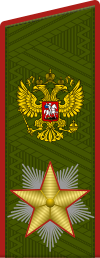
Back Маршал Расійскай Федэрацыі Byelorussian Maršál Ruské federace Czech Marschall der Russischen Föderation German Venemaa Föderatsiooni marssal Estonian Maréchal de la fédération de Russie French מרשל הפדרציה הרוסית HE Maresciallo della Federazione Russa Italian ロシア連邦元帥 Japanese რუსეთის ფედერაციის მარშალი Georgian Rusijos Federacijos maršalas Lithuanian
This article needs additional citations for verification. (April 2022) |
| Marshal of the Russian Federation Маршал Российской Федерации | |
|---|---|
 Marshal's star – big | |
 The insignia used from 2010 | |
| Country | |
| Service branch | |
| Rank group | General officer |
| Rank | Five-star rank |
| Formation | 11 February 1993 |
| Next lower rank | Army general |
| Equivalent ranks | Marshal of the Soviet Union |

Marshal of the Russian Federation (Russian: Маршал Российской Федерации, romanized: Marshal Rossiyskoy Federatsii) is the highest military rank of Russia, created in 1993 following the dissolution of the Soviet Union.[1][2] It ranks immediately above Army general and Admiral of the fleet (also called Fleet Admiral in some English-language texts), and is considered the successor to the Soviet-era rank of Marshal of the Soviet Union.
A Marshal of the Russian Federation outranks Generals of the Army (four stars), Colonel-Generals (three stars), Lieutenant-Generals (two stars) and Major-Generals (one star). It is roughly equivalent to American General of the Army and the British Field Marshal.[3]
The only officer so far to have held the rank was Igor Sergeyev, the former Minister of Defence, who had been elevated from the General of the Army of the Strategic Rocket Forces. Sergeyev was a Marshal of the Russian Federation from 1997 until his death in 2006.
The insignia for Marshal of the Russian Federation is similar to the one for the Marshal of the Soviet Union, with the Soviet emblem replaced by the Russian coat of arms. An officer who is given this rank would also wear the Marshal's star.
- ^ Новости, Р. И. А. (22 September 2010). "Воинское звание "Маршал Советского Союза". Справка". РИА Новости (in Russian). Retrieved 18 March 2022.
- ^ Galeotti, Mark (23 February 2017). The Modern Russian Army 1992–2016. Bloomsbury Publishing. p. 43. ISBN 978-1-4728-1909-3. Retrieved 17 March 2022.
- ^ "Supreme High Command of the Armed Forces of the Russian Federation". Air Force Magazine: 73. June 1995. Retrieved 17 March 2022.